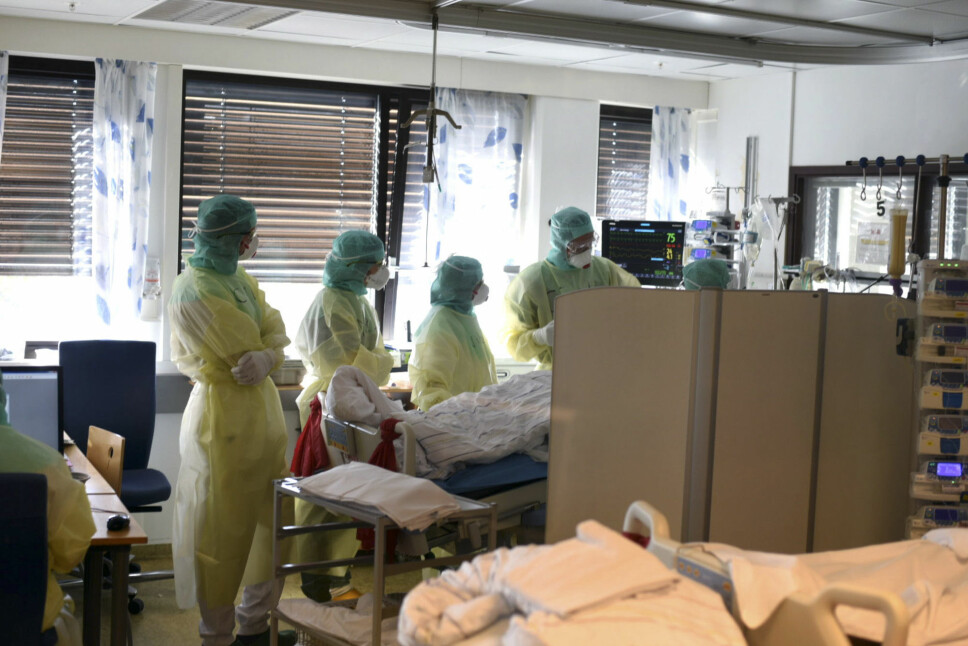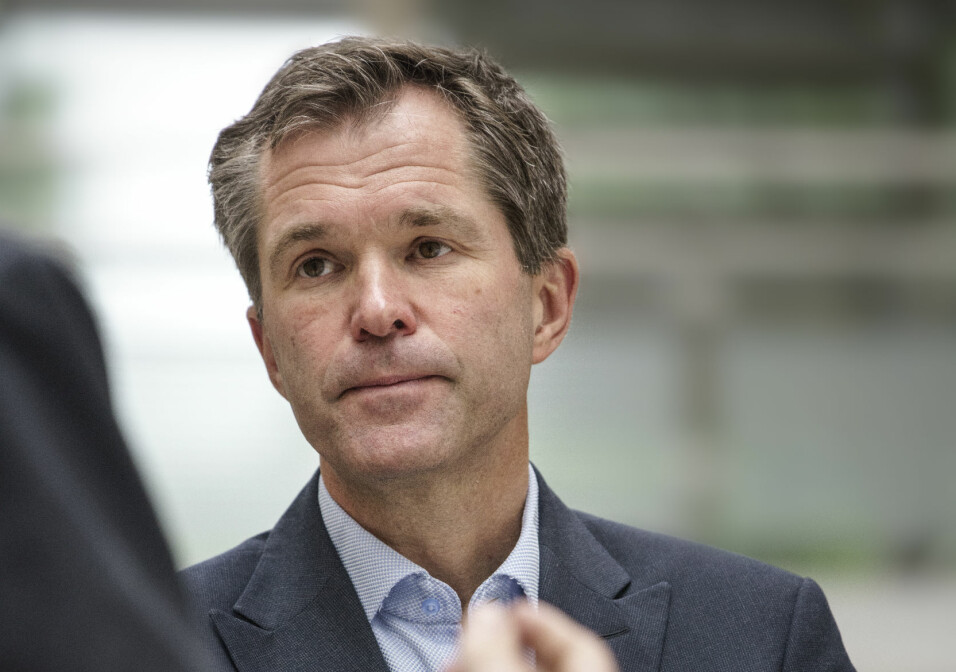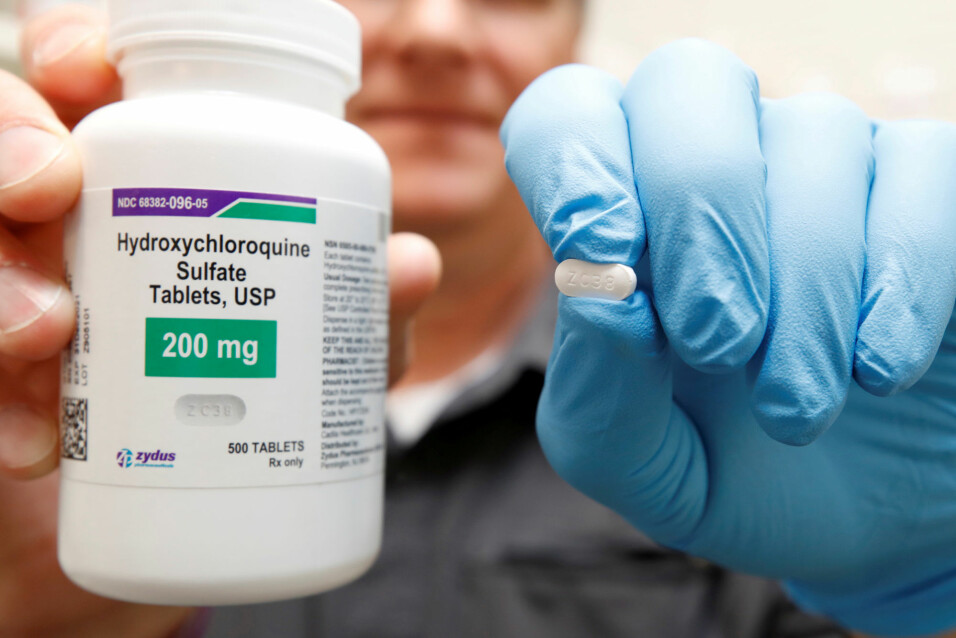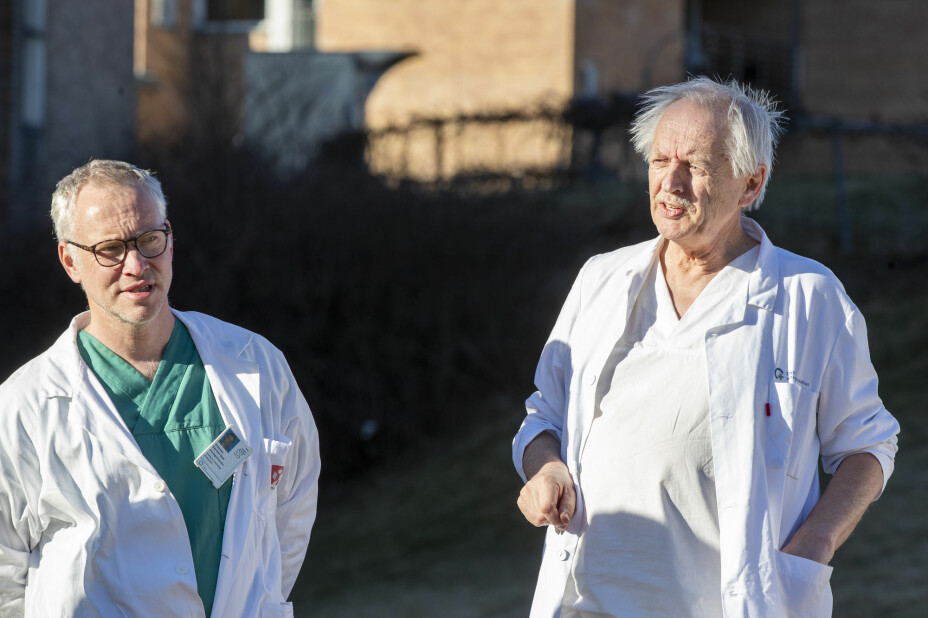
Promising treatments for COVID-19 were reported early on. So why haven’t there been bigger breakthroughs?
The whole world is looking for solutions. But while vaccine researchers seem to be storming ahead, it’s been much more chaotic for researchers studying COVID-19 treatments.
Things seemed very promising. The coronavirus had hardly been given a name before doctors and scientists had identified several possible treatments that could work.
There was a malaria drug, two HIV drugs in combination, and an Ebola drug that didn’t work for Ebola, but that might be effective against COVID-19.
And Donald Trump wasn't alone in thinking that the malaria medicine hydroxychloroquine would work. Belief in this treatment was so strong that even Norwegian doctors prescribed the drug to themselves and their loved ones in March, according to an article from the Norwegian broadcaster NRK.
"Data show panic and disorganization dominate the study of Covid-19 drugs" reported the online news magazine STAT in July. In partnership with an analytics firm, STAT journalists scrutinized all clinical trials that had been recorded as of 24 June.
They found that fully 39 per cent of the more than 1200 studies were too small to be able to provide clear results. They also often lacked control groups, and far too many focused on the malaria drug hydroxychloroquine, for which large clinical trials have subsequently found no effect.
Large studies absolutely necessary
John-Arne Røttingen, chief executive officer of the Research Council of Norway, was given the job of coordinating the major WHO study called Solidarity. He said in early April that researchers should have some results by the summer. The Solidarity trial has delivered on this promise to some extent, but things have not gone as smoothly as they had hoped.
In an article in the American magazine Science, journalist Kai Kupferschmidt wrote that the most useful results have come from a British “megatrial” called Recovery. Researchers from this study have reported:
- that the malaria medicine hydroxychloroquine does not work
- that the combination of the HIV drugs lopinavir and ritonavir has no effect
- that the steroid dexamethasone reduces the mortality of the very sickest COVID-19 patients
Nevertheless, "I don’t agree that it’s just the Recovery study that is providing robust answers," Røttingen said.
Solidarity has also found that the malaria medicine and the combination of HIV medicines has no effect, he said.
"What is clear is that it is absolutely necessary to have many patients enrolled in large clinical trials to see clear effects on changes in survival. And I hope that the belief in hydroxychloroquine has been laid to rest now," he said.

National authorities have been too slow
With the whole world as a recruitment site, Solidarity should have had access to lots of patients. But requirements for ethical approval and drug approval in the different countries have made things take longer than we all would have liked.
"Some countries have chosen to move quickly and have seen this as a pragmatic study. Other countries have wanted it to be more like a classic study led by the pharmaceutical industry and have demanded more detailed follow-up," Røttingen said.
Both Recovery and Solidarity have tried to create as simple protocols as possible for their studies. The goal has been for them to be easy for researchers, hospitals, doctors and patients to implement. But a simple design has not been enough.
"If we are going to get started faster next time, we have to have supranational approval mechanisms that work faster than each individual countries' governments," says Røttingen.
Something needs to be in place before the next pandemic, he says, and suggests that dummy protocols be created — that is, arrangements for studies that are feasible and can be implemented quickly.
Studies should be started as soon as new viruses are detected, says Røttingen. He suggests that countries can then be given a month to decide on whether they wish to drop out, if they decide they don’t approve of the trial - an opt-out rather than opt-in model.
The US disappoints
Røttingen agrees that there have been far too many small studies without control groups.
"Researchers can do meta-analyses and combine data from small studies. But too many studies have been far too small, and designed in completely different ways. That makes it difficult to do meta-analyses. So unfortunately, many of the small studies have been wasted," he says.
The US has been extremely disappointing in this regard, says Røttingen. He does give the country credit for its one big study, ACTT. Among other things, this study has shown that remdesivir, which was originally created for Ebola, results in shorter recovery times in patients compared to patients given a placebo.
"Beyond that, there has been little of use from the US. They have the best capacity in the world to conduct health research, so it is strange and very unfortunate that there have not been more results. But they have studies in progress," Røttingen said.
The US has published a number of so-called observational studies. These follow the course of patients who have been given various treatments. The problem with these studies is that it is difficult to say for certain what aspect of the treatment is responsible for the results, when there are no control groups, or other patients to compare results with. They can also be subject to systematic biases between different groups of patients that have not been controlled for.
"These studies have gone in all directions and given more fuel to the fire when it comes speculation about whether there are effects or not, like with the malaria medicine hydroxychloroquine," he said.
What will be the next thing we test?
The advantage of the Solidarity study is that it is global. As of today the study has enrolled more than 6300 patients from 24 different countries.
Norway joined quickly and has done a good job with recruitment. But Norway also got the pandemic under control relatively quickly, so there aren’t that many patients who can participate. England waited longer to introduce control measures and is one of Europe's worst affected countries. This has meant that the UK’s Recovery study has had plenty of patients to enrol — more than 12,000 have been included. But now the UK also has fewer patients.
"Solidarity is still recruiting almost as well as it did in the beginning," Røttingen said.
"Right now there is not that much COVID-19 in Europe, but there are a lot of cases in Iran, Indonesia, the Philippines and some Latin American countries," he said.
The question now is what treatments researchers should test on patients, given that one of the promising drugs has been ruled out.
An expert group at the WHO is working to identify the next drugs to be tested.
"The list includes some antiviral drugs, which stop the virus from multiplying in the body. But first and foremost, we want to test immune modulators, these are drugs that activate or regulate the immune system," Røttingen said.
He added that monoclonal antibodies are also of interest, but for the time being, they aren’t ready to be fully tested in a large phase 3 studies, where effects and safety is tested on large groups of thousands of patients.
The body's immune system develops antibodies to stop viruses. Patients can be given antibodies from the blood of COVID-19 patients who have recovered, which several studies are also looking at. Monoclonal antibodies however are developed using biotechnological methods in a laboratory and should be designed to directly attack the virus.
One monoclonal antibody called bemcentinib, originally created to treat cancer, was part of the ACCORD trial which tested drugs to treat COVID-19 in phase two trials. This trial has however ceased.
New drugs will likely be included in the Solidarity study this fall.

Have identified something that might work
At the Norwegian University of Science and Technology (NTNU), a group of researchers have tested different treatments in cell cultures. Testing treatments on cells in petri dishes in the laboratory is the first step towards testing drugs on animals and then humans. The NTNU researchers believe they have found one combination therapy that is particularly effective, an HIV medicine called nelfinar and a malaria drug called amodiaquine.
According to Denis Kainov at NTNU’s Department of Clinical and Molecular Medicine, these two pills prevent viral infection in cell cultures. The finding is so encouraging that he hopes someone else will test the drug combination in patients, according to an NTNU article published on sciencenorway.no.
"They are one of many different research groups that are working with this," Røttingen said.
In fact, practically the whole world is trying to solve this problem right now — so how do researchers decided what to do next? Is it a bit random?
"No, it’s not just coincidence — we try to use criteria," Røttingen said.
Nevertheless, it often boils down to what one researcher discovers, and what one doctor chooses to try out.

Difficult to get in touch with groups that are testing options
Magnar Bjørås, professor at NTNU’s Department of Cancer Research and Molecular Medicine was involved in the study that identified the promising drug combination.
"There are a ton of different trials going on across the globe, and of everything possible", he says. "As a result, we’ve found it difficult to get in touch with researchers who are testing promising findings from laboratory studies in the clinic."
Bjørås and his colleagues have also tried to contact pharmaceutical companies.
"They have not been so interested, because they are mostly working on their own projects," he said.
So the team then approached universities and hospitals in a number of countries.
"This is probably a more viable option than the big pharmaceutical companies," Bjørås said.
He agrees with Røttingen that the world was not prepared for how research should be conducted during a crisis like the coronavirus pandemic.
"If we had been better prepared, we might have had better treatments already. This could have been a life-saver for the seriously ill," he said.
In the intense pressure to find something that works at a speed that is much faster than ever before, researchers may have ended up slowing down development overall, the STAT article suggests.
Hindsight is always 20/20
"It is very easy to be right afterwards," says Andreas Barratt-Due. As chief physician at the intensive care unit at Oslo University Hospital, he has worked on the front line of treating Norwegian COVID-19 patients. It was absolutely clear that they had to investigate the effect of the treatments given, he says.
"With the benefit of hindsight, it’s easy to say that it was too bad that researchers invested time in studying that malaria medicine. But based on what we knew in February, it was important to clarify whether hydroxychloroquine worked. However, we should have been able to produce the data that showed that it did not work in early April," he said.
At the end of February, Barratt-Due didn’t know that Norway would bring the virus under control relatively quickly. This has meant fewer patients to study. But with a population of 5,4 million people, Norway will never produce the number of patients needed for a large clinical trial anyway.
"We can’t do these studies alone in Norway, we wouldn’t be able to get enough data to make any conclusions," he said.
WHO's Solidarity was a natural choice, and the global study's first patient was also a Norwegian, who joined at the end of March.
"If many more had joined the study from the beginning, from mid-March, then Solidarity would have been able to give us answers much faster," Barratt-Due said.

Norway on speed, Sweden had time
But no one was ready — not even in Norway.
"We worked fast, we worked day and night and did things we haven’t done before. The regulatory authorities, ethics committees and the Norwegian Medicines Agency were very forthcoming, we called people on their private numbers in the evening, afternoon and at night," Barratt-Due said.
The Swedes also wanted to participate, and contacted their Norwegian colleagues in the middle of March.
"But Swedish authorities never approved their participation," Barratt-Due said.
He is surprised by the large differences between the Nordic countries. Sweden never did join the big WHO trial.
"There was a lot of internal discussion in Sweden. The authorities did not like the dose of hydroxychloroquine that was going to be given, so there was a lot of back-and-forth about this. Discussions lasted from mid-March until late May. Then it became clear that the malaria medicine wasn’t the solution, and the Swedish numbers began to decline. So Sweden then decided not to participate in Solidarity and decided instead to use the Ebola medicine remdesivir", says Barratt-Due.
While the Swedes were painstakingly thorough, the Norwegians felt like they had no time to waste and moved as quickly as they could.
Denmark also chose not to be a part of the WHO's Solidarity trial.
"Instead, Denmark has carried out several smaller studies that will barely give them enough data to make conclusions about treatment," Barratt-Due said.
Norwegian hospitals more effective than dexamethasone
It is a complicated matter to figure out if a drug is helpful or not. In the British Recovery study, the end-point — that which is measured — is mortality. Does the medicine being tested result in fewer deaths or not?
But mortality from the disease is not uniform across countries, Barratt-Due points out.
The mortality rate in Norway for patients who end up in the hospital is 8 per cent, he says. One in five people who are admitted to the intensive care unit will die, or 20 per cent.
"The steroid dexamethasone has reduced mortality in England from 41 per cent to 30 per cent. This is a robust finding, but their mortality is still far higher than Norway’s,» he said. «Put it another way — if we had tested dexamethasone in Norway, we would not have necessarily shown the same results."
Barratt-Due speculates that if a Norwegian hospital with Norwegian capacity had been located in London, it might have resulted in a far greater reduction in mortality than dexamethasone.
So what makes Norway so good at intensive care treatment of COVID-19?
"We aren’t especially good at it, but we managed to establish good structures quickly, and perhaps most importantly — our hospitals were never under the kind of pressure that we have seen in other countries," says Barratt-Due.
"It’s been tough in Norway also, especially for the nurses, to work under these conditions, but our system was never overloaded," he said. "The people who cared for Norwegian COVID-19 patients, have been the ones who normally work with these kinds of patients ."

Hoping for a conclusion on remdesivir in the autumn
Barratt-Due is critical of the one existing study on the Ebola drug remdesivir that shows it helps seriously ill COVID-19 patients recover faster.
"The study is well executed, but it is a commercially controlled study by Gilead, the company that makes the medicine, and they have included patients who are not very ill," he said.
Barratt-Due himself is eagerly awaiting findings on remdesivir from the WHO Solidarity trial.
"I hope we have a conclusion from them soon," he said.
If it holds true that remdesivir actually has an effect, Barratt-Due believes that future studies will be about how and when patients should get it.
"I would think that the studies will show that it is best to get remdesivir early, so that the drug can help the body stop the virus from multiplying," he said.
It usually takes 10-20 years to develop a new medical drug, Barratt-Due points out. So there’s not likely to be a miracle cure right around the corner.
"It will probably be a bit like the flu. We have drugs that limit it, but they are not very effective. And they work best if you take them early on in the course of the illness. That's what we’re thinking about COVID-19 too — that it may be most beneficial if you can take something that slows down the multiplication of the virus early on, just after your symptoms start," he said.
If you end up in the intensive care unit, however, the body's immune activity has to be suppressed. In that case, the Recovery study has shown that the steroid dexamethasone can help.
"This is a very clear finding. If anyone comes to our intensive care unit tomorrow, it would be difficult not to give the person that medicine," Barratt-Due said.
We just have to try
The Norwegian Institute of Public Health's research overview of COVID-19 has a separate page for treatment studies. Over 38 treatments are included, in addition to separate tabs for "other or unspecified".
In Norway, Andreas Barratt-Due and his colleagues have collected blood samples and other biological material that the Solidarity study did not request — so that they can study how the immune system responds to the coronavirus. The result is a biobank with tests from all patients who have participated in the clinical study.
Other than that, researchers and doctors just have to keep trying.
"Nobody knows what works, and there is no point in developing a new medicine from scratch," Barratt-Due said. "We just have to keep trying things we think might have an effect."
Translated by Nancy Bazilchuk
———
Read the Norwegian version of this article at forskning.no
































